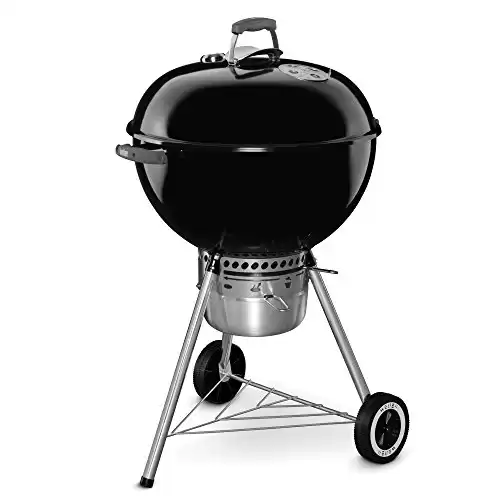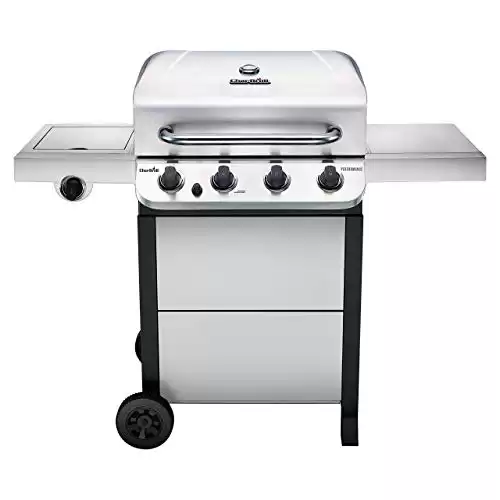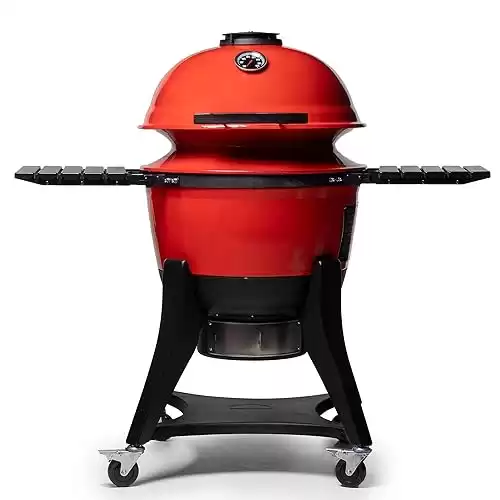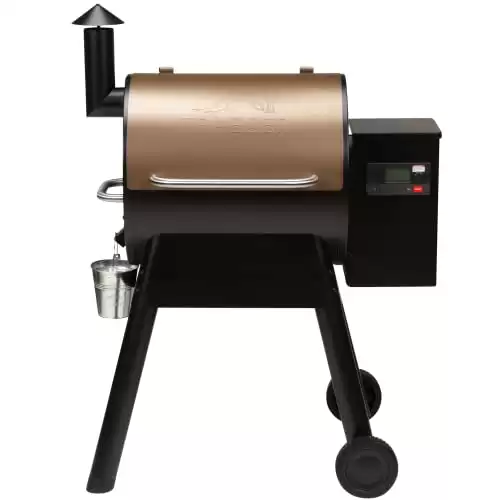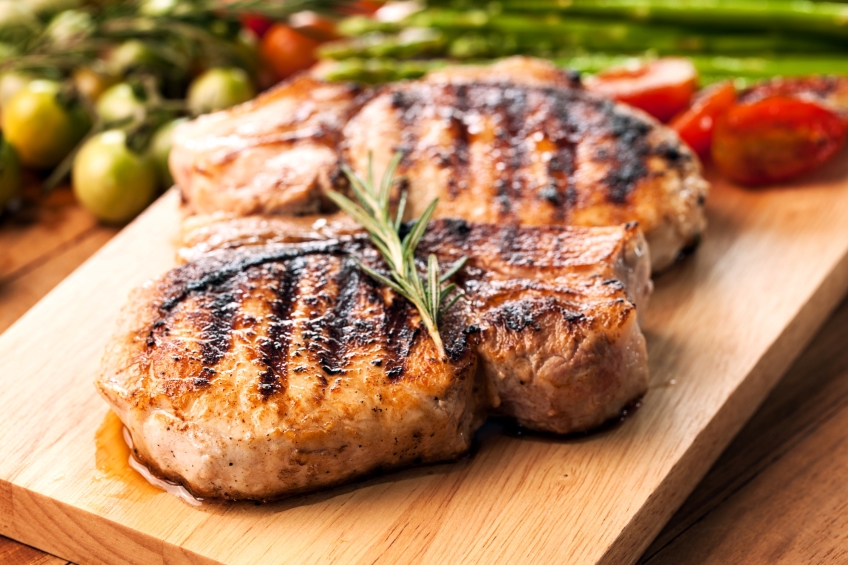
With a variety of options available, including charcoal, gas, and pellet grills, each type imparts its unique characteristics to the food.
Charcoal grills are widely regarded for providing a rich, smoky flavor that many consider unbeatable.
Gas grills offer convenience and temperature control, while pellet grills combine the best of both worlds, introducing flavorful wood pellets for an enhanced taste.
Every type has its supporters, but the distinct smoke produced by charcoal can elevate the flavor profile of grilled meats and vegetables significantly.
Choosing the right grill can transform an ordinary meal into an extraordinary culinary experience.
Understanding the differences among grill types not only informs the best choice for flavor but also enhances backyard gatherings and elevates cooking skills.
Grills that Give the Best Flavour
|
Our Rating:
4.6
|
Our Rating:
4.5
|
Our Rating:
4.1
|
Our Rating:
4.5
|
|
$219.00
|
$369.99
|
N/A
|
$1,062.41
|
|
Description: Features a classic design with modern upgrades, offering excellent heat retention and distribution for consistent grilling results. |
Description: Delivers a powerful 36,000 BTU. The cast-iron grates are coated with porcelain for rust resistance and easier cleaning. They retain heat effectively, ensuring even cooking and creating excellent grill marks. |
Description: Food tastes exceptionally good on the Kamado Joe because of its unique design, which combines the traditional kettle shape with advanced ceramic heat retention technology.Creates the perfect environment for grilling, smoking, and roasting, resulting in a richer, more flavorful taste. |
Description: Delivers authentic wood-fired flavor with precise temperature control up to 500°F. Its WiFIRE technology connects to home WiFi, enabling remote control through the Traeger app. |
Features a classic design with modern upgrades, offering excellent heat retention and distribution for consistent grilling results.
Delivers a powerful 36,000 BTU. The cast-iron grates are coated with porcelain for rust resistance and easier cleaning. They retain heat effectively, ensuring even cooking and creating excellent grill marks.
Food tastes exceptionally good on the Kamado Joe because of its unique design, which combines the traditional kettle shape with advanced ceramic heat retention technology.Creates the perfect environment for grilling, smoking, and roasting, resulting in a richer, more flavorful taste.
Delivers authentic wood-fired flavor with precise temperature control up to 500°F. Its WiFIRE technology connects to home WiFi, enabling remote control through the Traeger app.
Understanding Grill Types
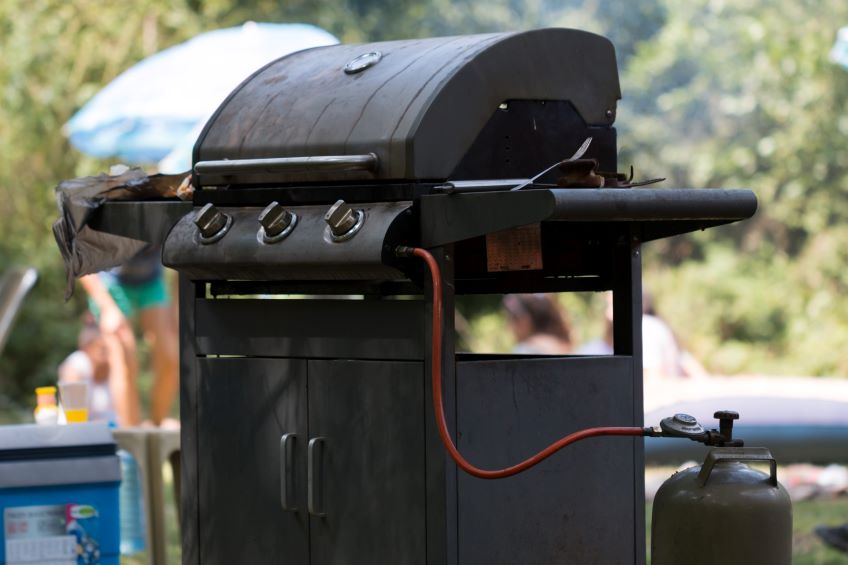
Different grill types offer unique flavors and cooking experiences.
The choice often depends on personal preferences, desired taste outcomes, and cooking styles.
Charcoal Grills
Charcoal grills are favored for their ability to impart a rich, smoky flavor to food.
They use charcoal briquettes or lump charcoal as fuel, which can reach high temperatures, ideal for searing meats.
The aroma released by burning charcoal adds depth to the grilled dishes.
Charcoal grilling requires more time to heat and demands attention to manage the temperature.
Many grill enthusiasts enjoy the traditional approach, appreciating the hands-on experience of lighting the grill and adjusting airflow.
Proper technique and time management can lead to delicious and flavorful results.
Gas Grills
Gas grills operate on propane or natural gas, offering convenience and ease of use.
They heat up quickly, allowing for more spontaneous cooking sessions.
While they may not provide the same smoky flavor as charcoal, many models include features like smoker boxes to enhance taste.
Precision control of temperature is a significant advantage, making gas grills ideal for those who prefer straightforward cooking without the need for igniting charcoal.
Maintenance is also simpler, as gas grills often require less cleanup than their charcoal counterparts.
Pellet Grills
Pellet grills combine the ease of gas with the flavor profile found in charcoal grilling.
They use compressed wood pellets as fuel, which are introduced automatically by an auger system.
This method allows for consistent temperature control while also infusing food with a unique wood-smoked flavor.
The variety of wood pellets available offers versatility in taste.
Pellet grills excel in slow cooking, making them suitable for smoking meats and preparing flavorful dishes.
They are praised for their ability to maintain precise temperatures over extended periods.
Kamado Grills
Kamado grills are ceramic grills that excel in heat retention and versatility.
The design allows for high-temperature cooking as well as low-and-slow methods.
Commonly fueled by charcoal, they provide a smoky flavor similar to traditional charcoal grills.
The thick walls of a kamado grill help maintain stable temperatures, making it easier to manage cooking processes.
They can be used for grilling, smoking, or even baking pizza, appealing to many grilling enthusiasts looking for a multi-functional option.
Their compact design and aesthetic appeal often make them a centerpiece in outdoor kitchens.
Electric Grills
Electric grills offer a convenient option for those with limited outdoor space or areas with fire restrictions.
They use electric heating elements, which eliminates the need for charcoal or gas.
While they may lack the intense smoky flavor associated with other grill types, some models include features to add wood chips for enhanced taste.
Electric grills are easy to use and maintain and often come with built-in thermostats for precise temperature control.
This makes them suitable for urban dwellers or individuals looking for a straightforward grilling solution.
Portable Grills
Portable grills come in various types and are designed for on-the-go grilling.
These smaller units can run on charcoal, gas, or even electricity, making them versatile for outdoor activities.
Their compact size makes them ideal for camping trips, picnics, or tailgating events.
Despite the smaller grilling surface, they can still produce flavorful meals.
Grill enthusiasts appreciate the convenience and flexibility of portable grills, which allow them to enjoy their passion for grilling in diverse settings.
Quality and heat retention can vary, so choosing a reputable brand can enhance the grilling experience.
Flavor Profiles of Different Grills
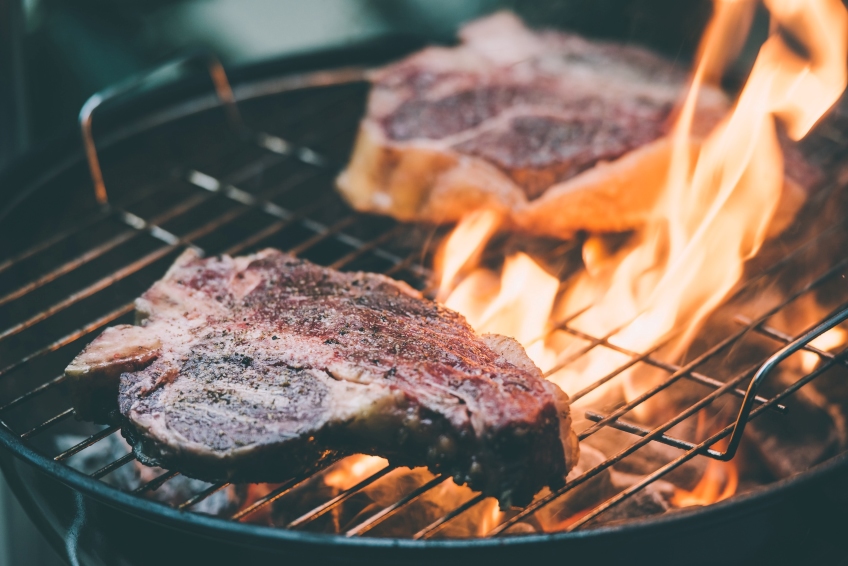
Each type of grill brings its own unique flavor profile, affecting the overall taste of the food prepared on it.
Understanding the differences can help in choosing the right grill for specific flavor outcomes.
Smokiness from Charcoal
Charcoal grills provide a distinct smokiness that enhances the flavor of food.
The combustion of charcoal creates a rich, deep flavor, often described as earthy or robust.
This is due to the byproducts of burning charcoal, which infuse the food with a traditional barbecue taste.
The type of charcoal used can also influence flavor.
For instance, hardwood lump charcoal gives a more intense smoke flavor compared to briquettes.
Additionally, adding wood chips can amplify the smokiness, allowing for customization in flavor profiles.
Foods like steak, ribs, and chicken often benefit significantly from the unique characteristics imparted by charcoal grilling.
Taste Test: Gas vs. Charcoal
Gas grills offer convenience and ease of temperature control, resulting in more consistent cooking.
However, many argue that they lack the depth of flavor associated with charcoal.
Gas produces a cleaner burn, which translates to milder flavors.
In taste tests, many prefer the richness that charcoal imparts.
Meats grilled over charcoal often exhibit a pronounced smoky flavor, while those cooked on gas maintain a more subtle taste.
The differences can be especially evident in smoky marinades or rubs, which shine through when grilled on charcoal.
Pellets for a Unique Flavor
Pellet grills combine the convenience of propane with the flavor profile of smoking wood.
They use wood pellets made from compressed sawdust, allowing for a variety of wood types such as hickory, mesquite, or applewood.
This variation provides options for customizing flavors.
Foods prepared on a pellet grill can take on complex flavor notes, depending on the wood pellets used.
For example, applewood pellets impart a mild sweetness, ideal for pork and poultry, whereas hickory provides a strong, hearty flavor, great for red meats.
The ability to control both temperature and flavor makes pellet grills a popular choice for many grill enthusiasts.
Construction and Design
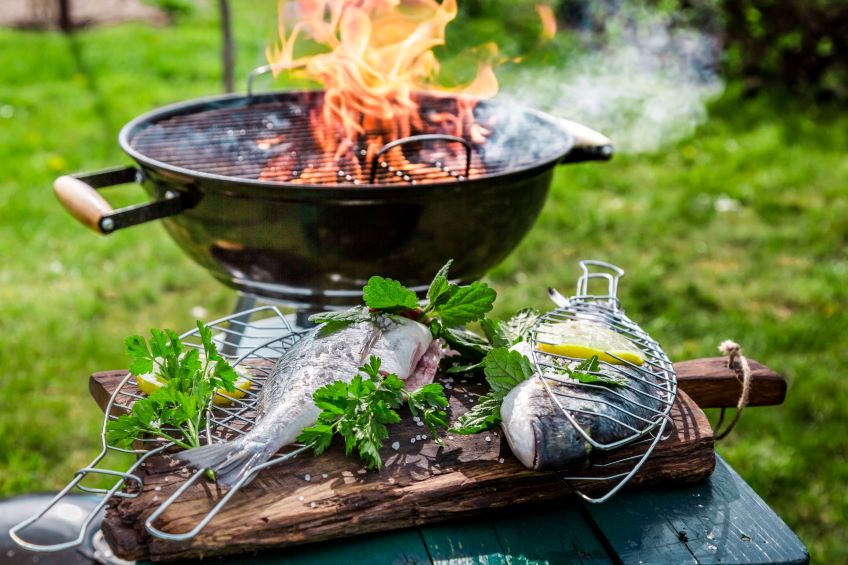
The construction and design of a grill significantly impact its performance and flavor output.
Key elements include the materials used, heat management features, and the grilling surface area available.
Materials and Durability
Grills are primarily constructed from a variety of materials, which affects their longevity and flavor development.
Stainless steel is a popular choice due to its resistance to rust and ease of cleaning.
Cast iron offers excellent heat retention but requires more maintenance to prevent rust.
 Ceramic grills, like the Kamado Joe, provide superior insulation and moisture retention, enhancing the flavor of grilled foods.
Ceramic grills, like the Kamado Joe, provide superior insulation and moisture retention, enhancing the flavor of grilled foods.
The choice of materials directly influences how well a grill can withstand heat and weather conditions, impacting both durability and cooking quality.
Heat Distribution and Retention
Effective heat distribution ensures even cooking and optimal flavor.
Kettle grills typically feature a rounded design that promotes convection, allowing heat to circulate uniformly around food.
In contrast, the Kamado Joe’s ceramic construction excels at heat retention, enabling it to maintain consistent temperatures over long periods.
This capability is particularly beneficial for smoking and slow-cooking.
Grills with poor heat distribution may lead to hot and cold spots, affecting flavor and cooking efficiency.
Grilling Surface and Capacity
The grilling surface directly correlates to cooking efficiency and versatility.
Larger grilling surfaces allow for cooking multiple items simultaneously, beneficial for gatherings.
Materials such as stainless steel and cast iron affect not only durability but also the way food sears and cooks.
A robust grilling surface enhances the flavor by allowing for proper caramelization.
For instance, a well-seasoned cast iron surface retains heat well and adds a distinct flavor profile to grilled foods.
The choice depends on personal needs, like the types of food prepared and the number of diners served.
Grilling and Cooking Techniques
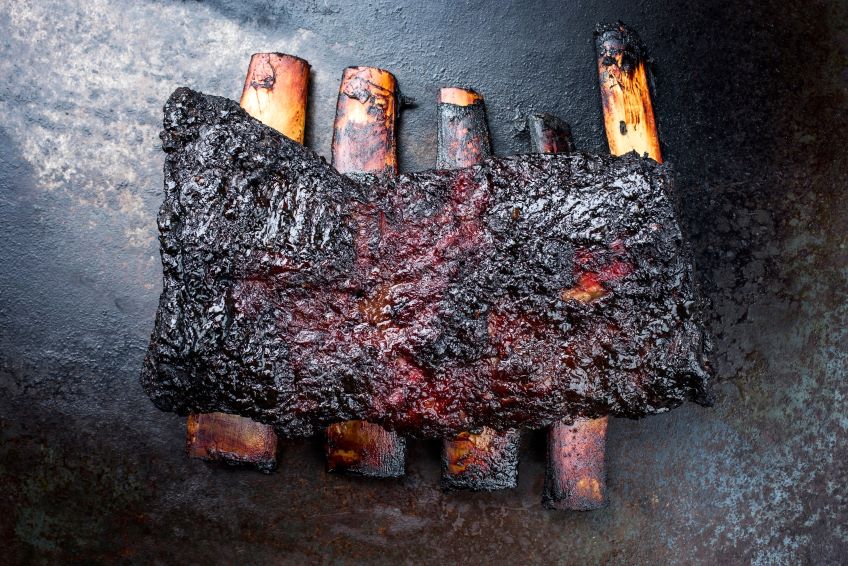
Understanding various grilling and cooking techniques is essential for achieving the best flavor.
This section touches on heat application methods, the importance of searing and smoking, and critical temperature control strategies.
Direct vs. Indirect Heat
Direct heat involves cooking food over the flame or heat source.
This method is ideal for quick-cooking items like burgers and steaks, resulting in a nice char and smoky flavor.
Indirect heat, on the other hand, places food away from the direct flame.
This technique is suited for larger cuts of meat that require longer cooking times, such as whole chickens or roasts.
It allows even cooking and helps retain moisture.
A combination of both methods can enhance flavors, allowing for a seared exterior with a tender interior.
Mastering these techniques helps in achieving different textures and flavors in grilled dishes.
Searing and Smoking Meat
Searing meat creates a flavorful crust through the Maillard reaction.
This technique locks in juices and enhances taste.
For optimal results, the grill should be preheated to high temperatures before placing the meat.
Smoking meat introduces additional flavor dimensions.
This slow-cooking method infuses meats with smoky aromas.
Using wood chips or chunks adds unique flavors, depending on the wood type.
Popular choices include hickory, mesquite, and applewood.
Combining searing and smoking can yield rich flavors and textures, making grilled dishes more appetizing.
Paying attention to the timing during these processes is crucial to avoid overcooking.
Managing Temperature Control
Temperature control is vital for successful grilling.
Maintaining appropriate cooking temperatures ensures evenly cooked food.
It is important to monitor the grill’s temperature using built-in thermometers or separate devices.
For indirect grilling, a consistent temperature of around 225°F to 250°F is preferred for smoking meats.
Those grilling directly, such as steaks, often aim for higher temperatures, around 450°F to 550°F.
Using a two-zone fire setup can aid in temperature management.
This allows a hot zone for searing and a cooler zone for finishing cooking.
Adjusting airflow and using vents can also help regulate the heat. Proper temperature control maximizes flavor and tenderness in grilled foods.
Ease of Use and Convenience

Grilling can be a delightful experience when the equipment is easy to operate and maintain.
Key considerations include startup time, cleaning requirements, and portability for outdoor cooking.
Startup Time and Preparation
The startup time varies significantly between grill types.
Gas grills offer quick ignition with the turn of a knob, allowing for immediate cooking.
This makes them user-friendly for those who may not have much time.
Charcoal grills, while providing a distinct flavor, require more preparation.
They often need a chimney starter to help ignite the coals, which takes additional time for heating.
Electric grills provide another option; they simply plug in and heat up quickly.
Given their convenience, they are ideal for urban settings where space and outdoor access may be limited.
Cleaning and Maintenance
Cleaning frequency and ease depend on grill type.
Gas grills tend to be easier to clean, as they often have removable grease trays and non-stick grates.
In contrast, charcoal grills present a more substantial cleaning task.
Users must dispose of ashes and ensure that residue does not affect future flavor.
Electric grills usually have removable plates or trays, making cleanup straightforward.
Maintenance is generally low, only requiring occasional wiping and checking of electrical components.
Portability for Outdoor Cooking
Portability is an essential factor for outdoor cooking.
Gas and charcoal grills come in both stationary and portable models.
Portable charcoal grills are particularly popular for camping and picnics but may be heavy to carry.
Gas grills offer lightweight options, often with collapsible legs and wheels for easier transport.
Electric grills are another portable choice, enabling grilling in environments without traditional fuel sources.
However, they require a power outlet, which can limit their use in certain outdoor settings.
Cost Considerations
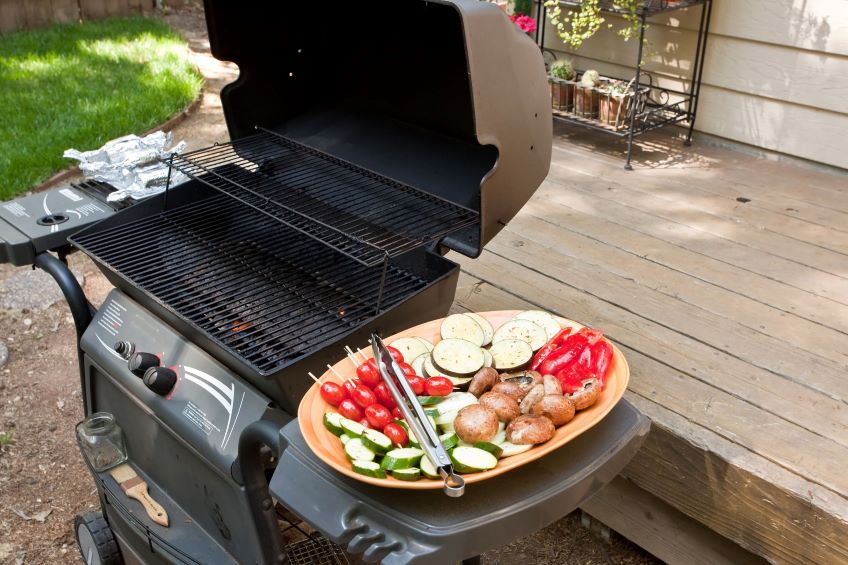
Cost is a crucial factor when selecting a grill.
Initial investments can vary significantly based on the type of grill, and ongoing costs depend on fuel efficiency and operational expenses.
Initial Investment
When considering grills, the initial cost is influenced by the type.
Propane grills generally range from $200 to $1,500, with varying features impacting price.
Natural gas grills may also start at about $300, often requiring a gas line installation.
Charcoal grills feature a wide price range, from $50 for basic models to $1,000 or more for premium options.
Lump charcoal and briquettes can add to the initial expense as good quality charcoal typically costs more.
Wood lump charcoal can elevate flavor but usually comes at a higher price than standard briquettes.
A buyer must balance features, materials, and long-term needs against the initial purchase price.
Fuel Efficiency and Running Costs
Understanding running costs helps in budget planning.
Charcoal grills often require more fuel per cooking session, leading to higher costs over time.
A typical bag of charcoal can cost around $10, providing about five to ten grilling sessions.
In contrast, propane grills offer relatively efficient fuel use.
A standard 20-pound propane tank costs about $15 to refill and provides several grilling sessions, averaging lower costs per meal than charcoal options.
Natural gas grills have minimal running costs after the initial setup.
Connecting to existing gas lines means lower fuel costs, appealing to frequent grillers.
Wood lump charcoal can be pricier but offers exceptional flavor. Weighing these ongoing costs assists in making a practical grilling choice.
Grill Choices for Different Cooking Preferences

Different grill types also cater to specific culinary styles and desired flavor profiles.
Best Grills for Beginners
For novice grillers, ease of use and reliability are key.
 The Weber Original Kettle Premium Charcoal Grill stands out for its straightforward design and ability to produce rich, smoky flavors.
The Weber Original Kettle Premium Charcoal Grill stands out for its straightforward design and ability to produce rich, smoky flavors.
Its compact size and built-in features, like a temperature gauge and adjustable dampers, make it user-friendly.
Gas grills also provide convenience.
 A model like the Char-Broil Performance 4-Burner combines simplicity with performance, offering quick heat-up times and precise temperature control.
A model like the Char-Broil Performance 4-Burner combines simplicity with performance, offering quick heat-up times and precise temperature control.
It also offers a sleek look and enhanced durability against weather and rust.
This grill is a good choice for family barbecues or entertaining guests.
 Electric grills, such as the George Foreman Indoor/Outdoor, are ideal for small spaces and allow year-round grilling without the hassle.
Electric grills, such as the George Foreman Indoor/Outdoor, are ideal for small spaces and allow year-round grilling without the hassle.
It features a durable non-stick griddle plate that makes cooking and cleanup effortless, while the included drip tray helps reduce fat for healthier meals.
Powered by electricity, it’s suitable for both indoor and outdoor use, eliminating the need for propane or charcoal.
Top Picks for Grill Aficionados
Grill enthusiasts often seek models that offer versatility and advanced features.
The Traeger Pro 575 Pellet Grill provides wood-fired flavor with digital temperature control.
This grill allows for smoking, grilling, and roasting, providing ample opportunities for experimentation.
Charcoal grills, like the Kamado Joe Kettle, offer solid heat retention, which enhances flavor through traditional methods.
Comparing Grills for Specific Dishes
Certain dishes benefit from specific grill types.
For classic burgers and steaks, gas grills, like the Weber Genesis E-325, offer excellent heat distribution and quick cooking times.
When preparing ribs or brisket, many chefs prefer Traeger Pellet Grills, as it allows for precise temperature control and smoke infusion over extended cooking periods.
For seafood, a gas grill is often ideal, allowing for easy temperature adjustments and quick cooking to maintain freshness.
Choosing the right grill depends heavily on the dishes being prepared and the cooking style desired.


